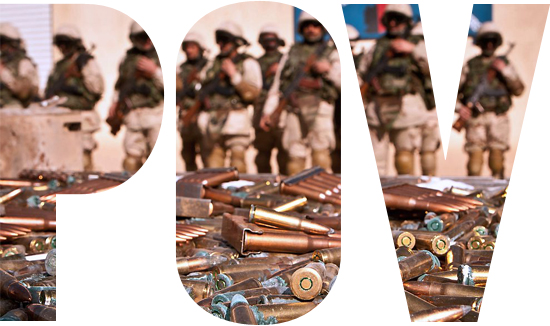POV: To Stop Bad Guys, Ratify the UN Arms Trade Treaty
Curbing military spending to halt spread of global weapons

Ammunition captured during a counterinsurgency operation in Afghanistan. Photo courtesy of the UK Ministry of Defence
The world is awash in weapons. According to the Stockholm International Peace Research Institute (SIPRI), the United Nations has imposed arms embargoes that prohibit giving weapons to, or trading them with, several countries and groups. The list of embargoed countries and groups in 2012 included: Cote d’Ivoire, Eritrea, Libya, North Korea, Somalia, and the Darfur region of Sudan, the Taliban, al-Qaeda and associated individuals and entities, and nongovernmental forces in the Democratic Republic of Congo, Iraq, Lebanon, and Liberia.
There are many comments one can make about the strategy of a mandatory embargo. But if one asks the question: “What would be happening right now if these embargoes were not in place?” the answer is clear. In the absence of a mandatory embargo, those involved would find it easier to gain access to conventional weapons. The power of these states and groups would be greater than the powers they now have.
The arms embargoes currently in force have been established on a “case by case” basis. A global Arms Trade Treaty, regulating cross-border flows to keep weapons from criminal or rights-abusing groups and nations, is being negotiated at the United Nations and was signed by Secretary of State John Kerry (Hon.’05) last April, although 50 US senators apparently oppose it. The treaty should be ratified by the Senate as quickly as possible—and then our attention should turn to a more robust agenda. The treaty is really the tip of the iceberg when it comes to military spending.
It stands to reason that a more systematic approach to controlling the global weapons trade could go a long way in advancing human security. Controlling the flow of arms into conflict regions can reduce the numbers of persons killed in these areas. Most weapons are useless without ammunition. And why should tanks and helicopters and fighter jets be delivered to groups intent on mass murder? The Second Amendment right to bear arms has nothing to do with a shipment of tanks.
Consider the logic of an arms race in this context. If one nation purchases arms in the global weapons market, what will neighboring countries do? Will they also feel pressured to purchase arms? The answer to this later question is probably yes. And if these adjacent heads of state purchase weapons, what advantage has been gained? Everyone in the region is better armed. But have the initial conditions of hostility or distrust suddenly improved?
From this point of view, a more robust, global Arms Trade Treaty can prevent unnecessary regional arms races. By sharply curtailing the market for conventional weapons, individual nations would not have the ability to swiftly upgrade their armed forces. Moreover, the money that would have been spent on upgrading the armies of these nations could instead be spent on development goals—including the provision of better health care and education. Surely the avoidance of unnecessary arms races is a good thing.
A strong Arms Trade Treaty has a lot going for it. Unfortunately, the headwinds facing this kind of effort are also quite strong. In 2012, the United States of America spent $682 billion on its armed forces, China spent $166 billion, and Russia $90.7 billion. If Chinese policy makers have genuinely adopted the goal of matching US military spending, this has massive implications. China will step up its military expenditures. The nations around China also will increase their spending. This process has already begun. According to SIPRI, “the five biggest recipients” of conventional weapons from 2008 to 2012 were India, China, Pakistan, South Korea, and Singapore. Moreover, the principal supplier of conventional weapons to India and China during this period was Russia—while the principal supplier of arms to South Korea and Singapore was the United States. Meanwhile, China and the United States were the chief suppliers to Pakistan. How, exactly, does all of this lead to a stable peace? And is this the best way to spend all of this money?
The tangled skein of military spending is daunting to consider. What is needed is a global Arms Trade Treaty coupled with a coordinated slowdown in the military spending of the world’s biggest military powers. Onward and upward in regard to military spending is not the best thing.
Neal Leavitt is a College of General Studies humanities lecturer and author of The Foreign Policy of John Rawls and Amartya Sen (Lexington Books, 2013). He can be reached at leavittn@bu.edu.
“POV” is an opinion page that provides timely commentaries from students, faculty, and staff on a variety of issues: on-campus, local, state, national, or international. Anyone interested in submitting a piece, which should be about 700 words long, should contact Rich Barlow at barlowr@bu.edu. BU Today reserves the right to reject or edit submissions. The views expressed are solely those of the author and are not intended to represent the views of Boston University.
Comments & Discussion
Boston University moderates comments to facilitate an informed, substantive, civil conversation. Abusive, profane, self-promotional, misleading, incoherent or off-topic comments will be rejected. Moderators are staffed during regular business hours (EST) and can only accept comments written in English. Statistics or facts must include a citation or a link to the citation.